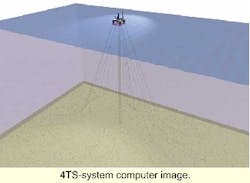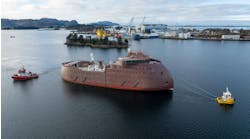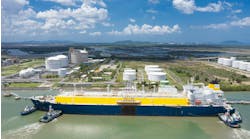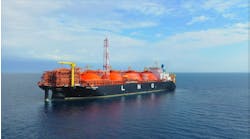FLOATING PRODUCTION: Semisubmersible producer designed for dry wellheads, top tensioned risers
Leiv Wanvik
Kværner Oil & Gas
The semisubmersible is often recognized as the "workhorse of the offshore industry." As the first wells moved off the beach and swamps, the initial mobile exploration units developed from bottom-supported barges into submersibles, and further into the semisubmersible as we know it today.
As the first floating production unit emerged (the North Sea's Argyle in 1974), the natural choice was a semisubmersible. Since then, the industry has seen mobile offshore production units (MOPU)s, based on semisubmersibles, multiply around the world. As production moved unto deeper water, other designs emerged, including floating production, storage, and offloading vessels (FPSO), tension leg platforms (TLP), and deep-draft floaters/Spars.
Deeper waters mean rising cost for development wells and greater concerns about flow assurance. These concerns include reservoir access as well as transporting fluids to the surface. The initial solution to these modern problems was a step back in technology, a return to the fixed platform in the form of jackets.
Not only are jackets stable, they can handle huge deckloads. This afforded surface completion and onboard drilling/workover equipment and gave birth to the dry completion unit (DCU), which seems to be the solution of choice for projects in the Gulf of Mexico, Brazil, and West Africa. Beyond what are considered conventional depths, floating production systems are the only game in town, but the DCU is still the completion method of choice.
TLPs and Spars offer a stable platform and the storage capacity necessary for well testing and other development activities. Because of this, these solutions have so far dominated the scene for deepwater DCUs.
Semisubmersible units equipped with hydraulic tensioning have to some extent been overlooked in this context. The reason may be that the industry has not recognized the semisubmersible as a "wellhead platform only" function. While a semisubmersible can carry a lot of process equipment, it offers no storage capacity; hence, it does not appear to be an attactive solution. Instinctively, the industry may feel no semisubmersible-based tensioning system can provide the necessary stability, even in benign environments like West Africa.
TLP with no tethers
When considering the DCU semisubmersible concept, it is useful to think of it initially as nothing more than a TLP with no, or extremely soft spring, tethers. In reality, some tether equivalent action is experienced from the riser array tensioning system (with hydraulic accumulators acting as a spring system) and the semi-taut catenary mooring leg arrangement.
What makes the semisubmersible interesting as a carrier of dry wellheads is the cost effectiveness. This is expressed in terms of unit cost for providing topside load carrying capacity. Topside load means the sum of fixed and variable payload acting at the top of column elevation (deck underside). Carrier efficiency may be measured by the ratio of deck operating weight to carrier hull steel weight.
Comparing concepts
A semisubmersible normally has a deck over hull steel weight ratio in the range of 2.0-2.5. This means its capacity for carrying a deck box weight is on the order of twice the steel weight of the hull. In comparison, a "classic Spar" has deck over hull steel weight ratio of about 0.7-1.3.
A recently introduced new design, the truss-spars design and multi-leg deep-draft floater designs (Kværner DDF) may be in the 1.0-2.0 range. The higher end here needs a large number of risers installed from day one, meaning a large number of wells have to be predrilled.
For TLPs, the corresponding ratio is in the 1.0-1.6 range. Tether technology is being developed that may improve the TLP's efficiency. However, its displacement will always have to carry the extra load of tether pretension (10-20% of displacement). In the above example, TLP tether weights are counted as a part of hull weight, and for the Spars, buoyancy tanks for riser tensioning are credited as topsides "weight."
Carrier efficiency
4TS-system computer image.
Floater deck-to-hull weight ratio is one of several illustrative indicators for measuring relative property costs of offshore plant carriers. Other contributors in a cost efficiency discussion are: engineering/documentation, fabrication, local content, platform assembly/commissioning, drilling plant, marine operations/installation, mooring system demands, riser system, operating close to technological thresholds, total field efficiency contribution, early production, and operational cost.
For a West Africa case, the fabrication/assembly and tow/installation related costs are important issues. The degree of inshore or quayside completion, as opposed to offshore completion, can produce significant cost differences. Concepts that avoid large-scale topsides lifting operations in remote areas produce large savings.
Several West Africa projects have been projected with one or more Spar wellhead DCU platform in combination with large 20,000 tons deckload FPSOs. A semi DCU may be used as a substitute for a Spar as a wellhead platform, but a more optimal solution may be to let the semisubmersible also carry the 20,000 tons deckload and relieve the storage vessel for its production role. The semi concept also offers periphery space for suspended tie-in risers.
In numerous concept studies from remote parts of the Norwegian Sea, Kværner has determined that a stand-alone semi with a process/ drilling plant in combination with a separate floating storage and offloading vessel is an economical way to develop a field. This provides the motivation for looking at a similar spread with a DCU semisubmersible system for West Africa.
Case studies
The Kværner Oil and Gas (KOG) concept uses a semisubmersible hull as a DCU carrier with added operational and cost benefits. The application of a large stroke capacity, multi-riser array tensioning system practically eliminates the need for tension legs, as in a TLP, and the costly overdesign for vertical motion suppression seen in a Spar.
KOG-FD has carried out a study on the feasibility of supporting an array of vertical top tensioned rigid risers from a traditional ring pontoon semisubmersible placed as a wellhead/production platform on a deepwater West Africa field location, as well as similar situations in Brazil and the Gulf of Mexico. The water depth was 1,350 meters in all cases.
The study is supported by the wide range of experience and data from earlier Kværner projects and studies. These include the P-26 semi on synthetic moorings in Brazil, as well as Åsgard B and Snorre B. No special form of optimization has been carried out, since the study was executed on the basis of data collected from existing Kværner ring pontoon semisubmersibles. In this way, response, including slow drift behavior, were well documented and readily available from model tests. The primary design considerations are:
- Minimize the relative motions between risers and the semisubmersible vessel
- Effective support of the rigid risers under all conditions
- Relative motion between the risers and the vessel can be reduced by optimization of the hull shape to minimize the wave-induced motion
- Design of the mooring system to minimize the vessel horizontal excursions and the riser setdown and allow the vessel to offset to a prescribed position
- Design the ballast system to ensure accurate control of the vessel operating draft
- Compartment size in the submerged part of the hull.
Hull design
The hull used in the case studies is a modified 55,000 cu meter displacement PDQ semisubmersible originally designed for the Norwegian Sea, and tested in the deepwater ocean basin laboratory at Marintek in Trondheim, Norway. Using such a vessel for the Brazil/West Africa case studies is "overkill," but may have some merit in the Gulf of Mexico case.
The corner column diameter was increased by one meter, and the hull airgap was reduced from 20 meters to 15 meters to suit West Africa conditions. This allows the initial 27,500 tons top of columns (TOC) load deck stability limit capacity to be upgraded to account for the large total tension load increase of 3,200 tons to 30,700 tons. The above approach indicates that there is room for considerable optimization for an emerging project. However, it serves the purpose of this feasibility study as it contains well-proven as-built information on weights and performance.
In a real case, there would be significant reduction in vessel displacement, as well as improved performance data due to hull optimization for the specific region where the vessel would operate (West Africa).
The deck is configured very much in line with the layout of a large TLP. The wellbay module is located centrally with the drilling substructure on top (skiddable in two directions). The arrangement for quarters, helideck, and process units follow traditional layouts.
Mooring system
The system used in the West Africa case consists of 12 mooring lines, symmetrically spread in four clusters. A steel catenary system with line pre-tension of 1,985 kN is applied, leading to a total vertical down pull of 15,900 kN (1,620 tons). The horizontal distance from fairlead to bottom anchor is 2,700 meters. Mooring analysis was performed using the Mimosa software.
The mooring line dimensions were based on the safety factors specified in API RP2SK. This analysis indicates the bottom chain at the anchor should not at any time be lifted from the seabed, meaning no vertical loading at the anchors. Both wave frequency and low frequency motions are included in the dynamic mooring analysis. The main results show that the safety factor requirements are satisfied for all design conditions.
Wellbay/subsea arrangement
Assuming a 16-well system, the risers are arranged in two 2 x 8 arrays, supported by two vertically movable tree-decks in openings in the topsides structures. This pattern is preferred in order to reduce the roll and pitch generated, and avoid the need for production riser tensioner (PRT) stroke.
Single-casing production risers (9 5/8-in. OD) are assumed, connected to the subsea wellhead with a hydraulic tieback connector. A taper stress joint ensures appropriate stress levels and acceptable bending moment loads on the subsea wellhead.
A 5-in. production tubing and a 3-in. gas lift line have also been assumed. It is anticipated that inhibited seawater may be placed in the annulus. The production risers are terminated at their upper end by the surface wellhead housing on which the christmas tree is mounted.
The calculated in-line tension for the production and the drilling risers are 1,500 kN and 8,000 kN, respectively. This also accounts for the weight of the equipment at the top, including parts of the flexible hoses.
Riser analysis
Riser stroke is the relative motion between the vessel and riser. Riser stroke has several causes including riser set-down (arising from vessel offset), riser sagging, dynamic riser deflections, vessel motions, tide and loading condition variations, and temperature elongation.
Also, low probability events have to be taken into account. These include gas kick pressure elongation and accidental hull damaged conditions. These problems require tensioner up-stroke compensation. Such accidental conditions will normally not be governing for the stroke capacity of a tensioning system as a deepwater case will allow some loss in riser tension without causing damage to the riser. The riser will take a more sag shape, but in a very controlled manner.
The riser tensioning system developed is a joint Kværner-Hydralift Inc. effort, which provides a total 40-ft compensation stroke for the Kværner deep-draft floater. The system is denoted 4TS, as it is a two-tier top-tensioning system. 4TS was introduced to overcome several problems associated with the single acting large stroke cylinder systems.
The single stroke design meant a major portion of the equipment protruded into the wave zone below the deck. 4TS consists of hydraulic cylinders that are connected to pressured fluid/gas reservoirs. The actual compressed gas volume determines the "spring stiffness" for the system. It works as two tensioners mounted in series on top of each other, hence, two "tiers" of tensioners.
The first tier of tensioners consists of the ordinary TLP-type production riser tensioners (PRTs) similar to the well-established Conoco type. The next tier is on the tree deck itself and is supported by a set of tree deck cylinders. The PRTs are designed with such a capacity that they can accommodate compensation of the individual risers and keep them properly tensioned at all times.
In addition, they will act as a collegium, fulfilling the gimbaling function as the floater pitches and rolls. The idea of the 4TS system is that the heave compensation is shared between the PRTs and the tree deck compensators. The two-tier philosophy of the 4TS system has several safety and operational features, especially when one considers a system designed as a tree deck with variable damping. The salient features compared to buoyancy can systems are:
- Freely ventilated wellbay and riser area
- Compact wellbay arrangement (8-10-ft spacing) frees deck space for process/utilities
- Elimination of buoyancy cans and adherent protective caissons, guides, and keel-joint below the waterline
- Sticktion/friction phenomena are easy to control, and riser tension can be monitored.
- Elimination of the keel joint/clearance between risers and pontoons at all times eases documentation/system credibility.
The system is split in two components, so hydraulic failure or hose rupture results in one component always being intact. Also, the 4TS system will never pay out more than half of the stroke capacity. In fact, the pay out is always less, as the other tier engages and shifts to a new equilibrium, picking up some of the troubled riser's slack. These events are not combined with severe storm cases, as they are low probability events. Each PRT is capable of working on two of its four cylinders.
Kvaerner/Hydralift estimates show that cost of riser stroke on single stroke cylinders is exponential (an 8.0-meter stroke cylinder is more than twice the cost of a 4.0-meter cylinder). Hence, talking of large stroke systems, the cost of the 4TS hydraulics is at least comparable to single stroke systems for the same capacity.
Field development model
In order to evaluate the cost efficiency of the DCU semi, a high-order cost comparison of two typical field development concepts for deepwater West Africa was performed. The cost comparison was based mainly on relative assessments of comparable building blocks and operations.
The benchmark concept includes a Spar-type floating wellhead platform with drilling and limited processing, an FPSO with 2 million bbl storage capacity, full processing with water, and gas injection and a remote off-loading buoy. The DCU semi concept includes a DCU semi with full processing and drilling facilities and an FSO with 2 million bbl storage capacity and alongside tanker loading capability.
The comparison shows a potential saving of $80 million for a West Africa deepwater location. These potential savings relate mainly to a radical reduction in the cost, risk, and number of marine operations, reduced offshore hook-up and commissioning time, and the shift of the process plant from the FPSO to the DCU semi. This shift allows the removal of the costly offshore loading buoy and transfer lines.
Editor's Note: More information on this concept is available in OTC paper 1296 "Deep Water Moored Semisubmersible with Dry Wellheads and Top Tensioned Well Risers"






